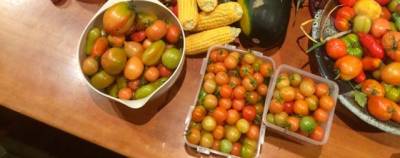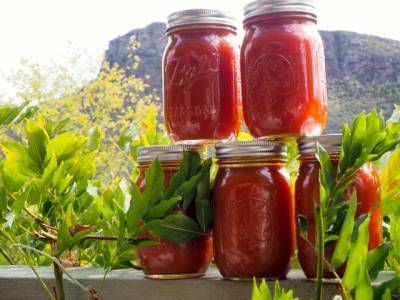By Jane Gibb
Tomatoes are the base ingredient for dishes from many different cultures including my favourite – Indian and Middle Eastern dishes.
Here at Griffins Hill Yoga Retreat, we grow a large crop of tomatoes each summer, bottle them and store them in our cellar for winter use.
Tomatoes grown in organic soil have noticeably superior flavour to those grown in glasshouses. They are even better still if you grow your own – the shorter the distance from the garden to the table, the more flavoursome your tomatoes will be.
Tomato Time
Each year, I have several annual rituals that occur throughout the period I call “Tomato Time”.
Tomato Time begins in August with the planting of tomato seeds in trays filled with organic growing media that optimises seed germination. 
I have to confess to a little trickery when it comes to tomato seedlings.
I grow four or five different varieties of tomatoes that are suited to the cooler climate of southern Australia. To coax them into germinating early, I put them in a little wooden greenhouse that Frank built for the purpose. (Building is a Jesse family strength.)
The trays sit on a heated mat that is a bit like an electric blanket for plants, keeping the little seedlings warm on cold August days. This tricks the seeds into thinking it’s springtime, speeding up the germination process.
When the seedlings are about three weeks old I transplant them into larger pots, but I still keep them warm and snug in the greenhouse.
In mid-October, I begin to carefully watch the weather patterns for when the night temperatures reliably settle between 6 - 10 °C, and day-time temperatures are between 18 – 25 °C.
There is a bit of guesswork in predicting the right moment to plant. Two years ago, it was mid-November before the temperature stabilised, but last spring was lovely and warm, so the tomatoes went into the garden in mid-October.
Perfect tomato weather prevailed, with temperatures in the high 20s through November and mid-30s in December.
One of delights of Tomato Time is keeping watch for the first ripe tomato and sharing this moment with fellow tomato enthusiasts. This year, we picked our first ripe tomato in early January.
We thought we were heading for a year of tomato heaven. But alas, at the end of the second week of January, a bout of cold weather blew in from the south. Unfortunately the cold weather kept up for most of January, bringing with it a “tomato crash.” It was autumn in February!
The tomatoes let me know that enough was enough – their flowers stopped turning into fruit. It was time to start bottling. (see notes for preserving tomatoes below.)
With my counter covered in bottled tomatoes, my Tomato Time had ended for another year.
Here are two ways to preserve tomatoes:
Bottled whole Roma tomatoes
Peel the whole tomatoes and remove any blemishes. The easiest way to peel tomatoes is to place them in a bowl, pour boiling hot water over them and then leave them sit for about five minutes. Pour out the water and slip the loose skin off the tomatoes.
Pack the whole tomatoes firmly in size 4 Fowlers jars. Fill jars close to the top with left-over juice from the tomatoes and water. Put rubbers and clips on the jars. Place the jars in the Fowlers preserving kit on the stove with water three-quarters of the way up the jars. Bring the water temperature to 55°C, and keep at this temperature for 30 minutes. Then increase the temperature to 75 °C for two and a half hours.
Place the jars in the Fowlers preserving kit on the stove with water three-quarters of the way up the jars. Bring the water temperature to 55°C, and keep at this temperature for 30 minutes. Then increase the temperature to 75 °C for two and a half hours.
Take the jars out of the water carefully and allow them to cool on the bench. After 48 hours, put the jars back into the preserver kit and repeat the cooking process. This will kill any yeast or bacteria that have not been destroyed in the first stage of preserving.
Tomato stock
Finely chop three large onions, and sweat in olive oil on a low heat in a large heavy based saucepan. Roughly chop 2.5 kg of tomatoes and add to the onions with two teaspoons of salt. Bring to boil and simmer until the liquid has reduced by about one third.
Push the tomatoes through a sieve or through a mouli (a very handy kitchen tool). I use the finest mouli attachment to remove the seeds and skin, which can make the stock a little bitter.
Place the liquid back on the stove and bring to boil.
Sterilise some storage jars and lids – I use Mason preserving jars that that have replaceable lids so jars can be used for many years.
Boil the jar lids in water for a few minutes and place the jars in the oven at 150 degrees until to hot to touch. When they are cool, fill with the boiling tomato liquid and put the lids on.
Yum. Enjoy!
Join over 2,000 of your peers and get fortnightly articles delivered to your in box.